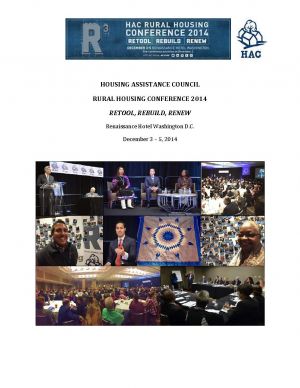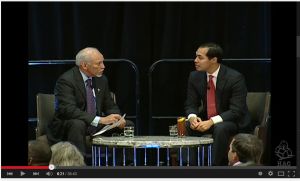HAC News Formats. pdf
November 28, 2012
Vol. 41, No. 23
• Congressional leadership will change for housing • Claim filing period open for Hispanic and women farmers and ranchers • CFPB to consolidate more mortgage disclosure requirements • FHFA sets new housing goals and rating system for Fannie Mae and Freddie Mac • HUD reopens comment period on smoke-free policies • RUS proposes targeting changes for rural broadband program • NSP closeout requirements revised • New rating system adopted for examining GSEs • Deficit reduction without substantial revenues likely to require deep housing cuts • Census briefs show recession’s impact
November 28, 2012
Vol. 41, No. 23
CONGRESSIONAL LEADERSHIP WILL CHANGE FOR HOUSING. The 113th Congress, which starts work in January, will have changes in key committee leadership positions and in committee rosters. Sen. Herb Kohl (D-WI) is retiring, so his chairmanship of the Senate Agriculture Appropriations Subcommittee will move to someone else. Iowa’s Tom Harkin is next in line. Democratic Reps. Barney Frank and John Olver of Massachusetts are also retiring, so their ranking member (top minority party) slots on the House Financial Services Committee and the Transportation-HUD Appropriations Subcommittee will change. Maxine Waters (D-CA) on Financial Services and Ed Pastor (D-AZ) on THUD are next in line. Also on House Financial Services, Housing Subcommittee Chair Rep. Judy Biggert (R-IL) lost her re-election bid. Rep. Jen Hensarling (R-TX) will be the new chair of the full Financial Services Committee, as current chair Spencer Bachus (R-AL) rotates due to term limits on chairmen. Also moving due to term limits will be Senate Banking Committee ranking member Richard Shelby (R-AL). HAC will provide further updates as information becomes available.
CLAIM FILING PERIOD OPEN FOR HISPANIC AND WOMEN FARMERS AND RANCHERS. Anyone improperly denied farm loan benefits by USDA between 1981 and 2000 because s/he is Hispanic or female can file a claim before March 25, 2013 for cash payment or loan forgiveness. Call 1-888-508-4429 or visit www.farmerclaims.gov.
CFPB TO CONSOLIDATE MORE MORTGAGE DISCLOSURE REQUIREMENTS. The Consumer Financial Protection Bureau issued a rule in July (see HAC News, 8/22/12) proposing to integrate some disclosures required for homebuyers, as mandated by the Dodd-Frank Act. CFPB will delay some other new disclosure requirements until it finalizes its July proposal. See Federal Register, 11/23/12. Contact Michael G. Silver, CFPB, 202-435-7700.
FHFA SETS NEW HOUSING GOALS AND RATING SYSTEM FOR FANNIE MAE AND FREDDIE MAC. In a final rule the Federal Housing Finance Agency sets new levels for Fannie’s and Freddie’s purchases of affordable housing mortgages in 2012, 2013, and 2014. The existing structure of the goals remains (with targets for low- and very low-income homeowners and affordable rentals, but no specifically rural targets). The new single-family goals are lower than those for 2010 and 2011. The new multifamily goals are higher than for 2010 and 2011, but they decrease each year from 2012 through 2014. See Federal Register, 11/13/12 or FHFA’s website. Contact Paul Manchester, FHFA, 202-649-3115.
HUD REOPENS COMMENT PERIOD ON SMOKE-FREE POLICIES. The deadline is now January 22, 2013 to comment on smoke-free policies for public and multifamily housing (see HAC News, 10/10/12). See Federal Register, 11/23/12, or www.regulations.gov. Contact Shauna Sorrells, HUD, 202-402-2769.
RUS PROPOSES TARGETING CHANGES FOR RURAL BROADBAND PROGRAM. USDA’s Rural Utilities Service proposes to amend its regulations for the Community Connect Grant Program enabling it to target resources to geographical as well as technological areas of need. Comments are due January 15, 2013. See Federal Register, 11/16/12 or https://www.regulations.gov. Contact Kenneth Kuchno, RUS, 202-690-4673.
NSP CLOSEOUT REQUIREMENTS REVISED. HUD is making requirements for closing out grants under all three rounds of the Neighborhood Stabilization Program “nearly identical” to those for CDBG. See Federal Register, 11/27/12. Contact Stanley Gimont, HUD, 202-708-3587.
NEW RATING SYSTEM ADOPTED FOR EXAMINING GSES. FHFA will use a new rating system when examining Fannie Mae and Freddie Mac, the Federal Home Loan Banks, and the Banks’ Office of Finance. The system will assess capital, asset quality, management, earnings, liquidity, sensitivity to market risk, and operational risk (“CAMELSO”). See Federal Register, 11/13/12 or FHFA’s website. Contact Karen Walter, FHFA, 202-649-3405.
DEFICIT REDUCTION WITHOUT SUBSTANTIAL REVENUES LIKELY TO REQUIRE DEEP HOUSING CUTS. The alternatives to sequestration could force even greater cuts in housing assistance, according to Deficit Reduction Deal Without Substantial New Revenues Would Almost Certainly Force Deep Cuts in Housing Assistance, a new report by the Center on Budget and Policy Priorities.
CENSUS BRIEFS SHOW RECESSION’S IMPACT. Three briefs, using statistics from the American Community Survey, describe increases in household sharing and public assistance. Poverty and Shared Households by State: 2011 reports the proportion of adults living with others who are not immediate family increased from 2007 to 2011. That paper, as well as Food Stamp/Supplemental Nutrition Assistance Program Receipt in the Past 12 Months for Households by State: 2010 and 2011 and Public Assistance Receipt in the Past 12 Months for Households: 2010 and 2011, include data for each state as well as the United States. A Census Bureau summary is also posted online.



